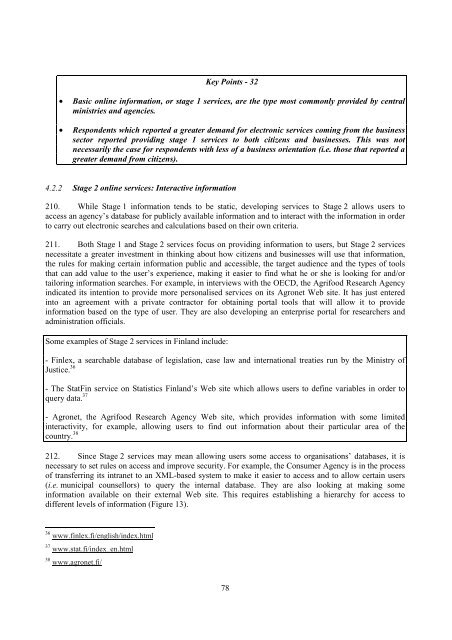e-GOVERNMENT IN FINLAND - ePractice.eu
e-GOVERNMENT IN FINLAND - ePractice.eu
e-GOVERNMENT IN FINLAND - ePractice.eu
You also want an ePaper? Increase the reach of your titles
YUMPU automatically turns print PDFs into web optimized ePapers that Google loves.
Key Points - 32<br />
x Basic online information, or stage 1 services, are the type most commonly provided by central<br />
ministries and agencies.<br />
x Respondents which reported a greater demand for electronic services coming from the business<br />
sector reported providing stage 1 services to both citizens and businesses. This was not<br />
necessarily the case for respondents with less of a business orientation (i.e. those that reported a<br />
greater demand from citizens).<br />
4.2.2 Stage 2 online services: Interactive information<br />
210. While Stage 1 information tends to be static, developing services to Stage 2 allows users to<br />
access an agency’s database for publicly available information and to interact with the information in order<br />
to carry out electronic searches and calculations based on their own criteria.<br />
211. Both Stage 1 and Stage 2 services focus on providing information to users, but Stage 2 services<br />
necessitate a greater investment in thinking about how citizens and businesses will use that information,<br />
the rules for making certain information public and accessible, the target audience and the types of tools<br />
that can add value to the user’s experience, making it easier to find what he or she is looking for and/or<br />
tailoring information searches. For example, in interviews with the OECD, the Agrifood Research Agency<br />
indicated its intention to provide more personalised services on its Agronet Web site. It has just entered<br />
into an agreement with a private contractor for obtaining portal tools that will allow it to provide<br />
information based on the type of user. They are also developing an enterprise portal for researchers and<br />
administration officials.<br />
Some examples of Stage 2 services in Finland include:<br />
- Finlex, a searchable database of legislation, case law and international treaties run by the Ministry of<br />
Justice. 36<br />
- The StatFin service on Statistics Finland’s Web site which allows users to define variables in order to<br />
query data. 37<br />
- Agronet, the Agrifood Research Agency Web site, which provides information with some limited<br />
interactivity, for example, allowing users to find out information about their particular area of the<br />
country. 38<br />
212. Since Stage 2 services may mean allowing users some access to organisations’ databases, it is<br />
necessary to set rules on access and improve security. For example, the Consumer Agency is in the process<br />
of transferring its intranet to an XML-based system to make it easier to access and to allow certain users<br />
(i.e. municipal counsellors) to query the internal database. They are also looking at making some<br />
information available on their external Web site. This requires establishing a hierarchy for access to<br />
different levels of information (Figure 13).<br />
36 www.finlex.fi/english/index.html<br />
37 www.stat.fi/index_en.html<br />
38 www.agronet.fi/<br />
78
















